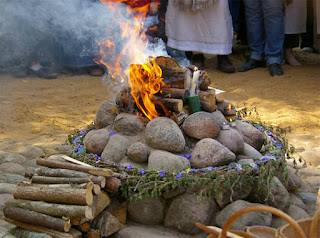At the Vernal Equinox, we begin a new cycle on the Medicine Wheel of Life, entering the East -- home of the rising sun, morning, birth, beginnings, and the spring season. Spring arrives when the earth is tilted so that the sun is directly over the equator. In the Northern Hemisphere, the first day of spring is on or about March 21. This is the day of the Vernal Equinox. Vernal means spring; Equinox means equal night. Night and day are the same length, each lasting exactly twelve hours on this day. It is at this time when light and darkness are in balance. The forces of feminine and masculine energy, yin and yang, are also in balance at this time, providing a unique opportunity to tune in and find our inner balance, harmony, and alignment. The 2023 Vernal Equinox will occur on Monday, March 20, 2023 at 21:24 Coordinated Universal Time (UTC).
Throughout human history, people in the northern parts of the world have celebrated the Rites of Spring, marking the end of earth's winter sleep and the start of spring when everything is reborn. Ancient cultures connected spring with the return of life to the earth. The return of spring in ancient times was of more consequence than it is to us today because winter food and fuel shortages ended, inclement weather waned, and crops could be planted. Pagan customs such as lighting fires at sunrise for renewed life and protection of the crops still survive in South America as well as in Europe.
In China, the Vernal Equinox has always been celebrated as the time of new beginnings, of action, of planting seeds for future grains, and of tending gardens. Spring is a time of the earth's renewal, a rousing of nature after the cold sleep of winter. The life energy, symbolized by thunder, erupts from the depths in early spring to awaken the dormant seeds to new life. The yearly cycle begins in the spring when thunder quickens the renewal of life. Winter still has its grip on the land, but the days are lengthening and the light is growing stronger by the day. Spring is finally here... I hope we can be inspired by nature's reawakening to renew our own lives.
In China, the Vernal Equinox has always been celebrated as the time of new beginnings, of action, of planting seeds for future grains, and of tending gardens. Spring is a time of the earth's renewal, a rousing of nature after the cold sleep of winter. The life energy, symbolized by thunder, erupts from the depths in early spring to awaken the dormant seeds to new life. The yearly cycle begins in the spring when thunder quickens the renewal of life. Winter still has its grip on the land, but the days are lengthening and the light is growing stronger by the day. Spring is finally here... I hope we can be inspired by nature's reawakening to renew our own lives.
The Descent of the Feathered Serpent
In March of 1995, I was fortunate enough to visit the Pyramid of Kukulkan at Chich'en Itza, Mexico on the vernal equinox when the sun projects an undulating pattern of light on the northern stairway for a few hours in the late afternoon--a pattern caused by the angle of the sun and the edge of the nine steps that define the pyramid's construction. These triangles of light link up with the massive stone carvings of snake heads at the base of the stairs, suggesting a massive serpent snaking down the structure.
According to legend, twice a year when the day and night are in balance, this pyramid dedicated to Kukulkan (or Quetzalcoatl), the feathered serpent god, is visited by its namesake. On the equinox Kukulkan returns to earth to commune with his worshipers, provide blessing for a full harvest and good health before entering the sacred water, bathing in it, and continuing through it on his way to the underworld.
In March of 1995, I was fortunate enough to visit the Pyramid of Kukulkan at Chich'en Itza, Mexico on the vernal equinox when the sun projects an undulating pattern of light on the northern stairway for a few hours in the late afternoon--a pattern caused by the angle of the sun and the edge of the nine steps that define the pyramid's construction. These triangles of light link up with the massive stone carvings of snake heads at the base of the stairs, suggesting a massive serpent snaking down the structure.
According to legend, twice a year when the day and night are in balance, this pyramid dedicated to Kukulkan (or Quetzalcoatl), the feathered serpent god, is visited by its namesake. On the equinox Kukulkan returns to earth to commune with his worshipers, provide blessing for a full harvest and good health before entering the sacred water, bathing in it, and continuing through it on his way to the underworld.


No comments:
Post a Comment